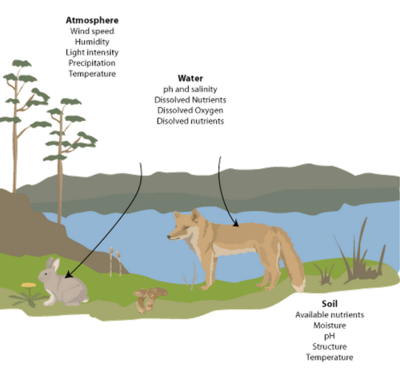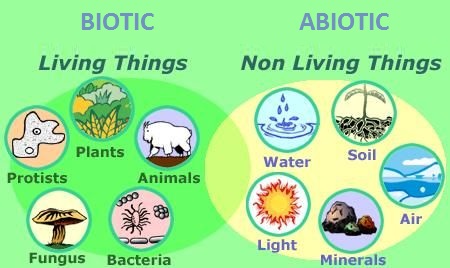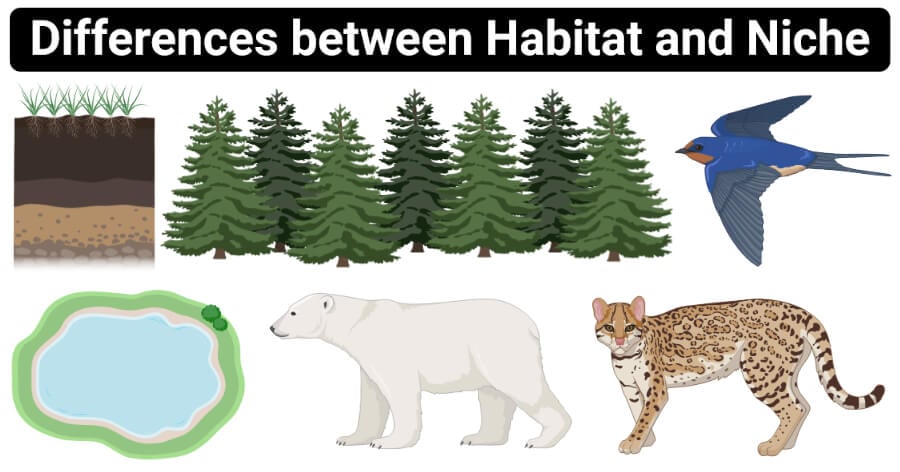Three Factors That Can Be Used to Describe a Habitat
Food source natural predators roaming territory vs. These environmental factors are known as eco- factors or.

Ecology Habitat Abiotic Biotic Factors Pathwayz
The average amount of sunlight received each day the range of annual temperatures and average yearly rainfall can all.

. However by expanding farming many animals have to relocate and find new habitats which may lead to a decrease. A habitat is made up of physical factors such as soil moisture range of temperature and availability of light as well as biotic factors such as the availability of food and the presence of predators. What are three factors that can limit the population of a species in its natural habitat.
Geographic range home range resource patches or habitat resources. In addition intraspecific competition influences habitat use because larger individuals can force smaller conspecifics out of preferred habitats. Agriculture can be a main cause of habitat destruction.
1 distance to the nearest stream 2 distance to the tip of the branch and trunk 3 nest height 4 substrate tree or shrub height 5 thickness of nest-supporting branch and 6 vegetation type. Studies comparing habitat use to availability help wildlife ecologists assess a species habitat requirements but are not as useful when trying to predict species distribution across landscapes. Answer to Solved Describe 3 factors associated with habitat.
Mutations Migration selective breeding population size and sexual reproduction Describe three major causes of he loss of biodiversity. Up to 24 cash back A Identify which beetle phenotype or phenotypes will most likely be favored in the habitat after the fire. Draw or describe them.
What are the 4 layers in a forest ecosystem. In order to plant large amounts of crops or to produce plenty of meat large areas of land have to be used. A habitat is said to have a suitable ar range ment when it has the correct amount of all of these.
Moisture soil and other factors. For example to avoid predation by mammalian and avian predators larger fish may use deeper habitats 8252 whereas small fishes may use shallow habitats to avoid predation by larger piscivores 52. Examples of habitats are jungles forests deserts oceans and lakes.
CLIMATE CHANGE AND O CEAN ACIDIFICATION 6 WATER QUALITY DEGRADATION 6. These and other abiotic nonliving factors will affect the kind of traits an organism must have in order to survive there. The type of natural selection you identified in part b will change the phenotype distribution in the beetle.
The temperature the amount of rainfall the type of soil and other abiotic factors. Habitat provides shelter food and water space to obtain food and water space to rest find a mate and shelter from predators. It is the place where the animal is naturally found.
Factors affecting species and habitats 1. Some of the major ecological factors that constitute the environment of an organism are as follows. Population size and density are the two main characteristics used to describe and understand populations.
The main component s of a habitat are shelter water food and space. Many farmers try to expand their farming land on a continuous basis. A habitat is an environment that provides an animal with the food water temperature and protection it needs.
Up to 24 cash back amount of sunlight received each day the range of annual temperatures and average yearly rainfall can all describe a habitat. A habitat can be described by listing the climate the terrain and the plants and animals that live there. Land mass population density.
B Identify the type of natural selection directional stabilizing or disruptive that will most likely act on the beetle population. The overall success of organisms survival depends on their ability to obtain these things. Habitat is a species-specific concept so unless monitoring is focused on habitat types a biophysical classification of the environment then a set of habitat elements must be identified as important to one of four levels of habitat selection.
To describe the nest sites we recorded the following data. Describe the habitat of the pitcher plant of the. Describe 3 factors that you can use to identify tree species.
Many factors are used to describe a habitat. Within a particular habitat a population can be characterized by its population size N the total number of individuals and its population density the number of individuals within a specific area or volume. Sometimes a habitat can meet some components of a suitable arrangement but not all.
Habitat types are based on the idea that on a given site the same successional patterns will repeat after disturbances and that the climax forest plants and trees are a meaningful index of soils topography precipitation and other factors affecting the growth of trees and other organ-isms there. Describe 3 factors that you can use to identify tree species. In any eco-system a living organism is influenced by a number of factors and forces.
Knowledge application - use your knowledge to answer questions about the types of things a habitat can provide and the abiotic factors in any. How does the Des Plaines River influence the habitat types found in Ryerson Conservation Area. Habitat fragmentation can be defined as process by which large and contiguous habitats get divided into smaller isolated patches of habitats.
Describe three factors that influence the genetic diversity of a population. Resource selection functions provide methods for quantifying a species habitat preferences and can include both categorical eg vegetation habitat type etc and continuous variables eg.

Biotic And Abiotic Factors Worksheet Google Search Abiotic Social Studies Worksheets Teaching Biology

No comments for "Three Factors That Can Be Used to Describe a Habitat"
Post a Comment